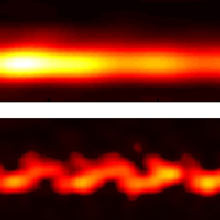A Guiding Light for Silicon Photonics
A new way of controlling the path that light takes as it passes through silicon could help overcome one of the big obstacles to making an optical, rather than electronic, computer circuit. Researchers at Caltech and the University of California, San Diego, have taken a step toward a device that prevents light signals from reflecting back and causing errors in optical circuits.

Chips that compute with light instead of electrons promise to be not only faster, but also less expensive and more energy-efficient than their conventional counterparts. But to be made economically, many believe, photonic chips must be made from silicon, using equipment already being used to build electronic microchips.
Researchers have made many of the necessary elements for a silicon photonic circuit already, including superfast modulators for encoding information onto beams of light, and detectors to read these beams.
But the way light travels through silicon remains a big problem. Light doesn’t just go in one direction—it bounces around and even reflects backward, which is disastrous in a circuit. If an optical device were designed to receive two inputs and a third input reflected back in, that would cause an error. As a circuit became more complex, error-causing reflections would overwhelm it.
The Caltech and UCSD researchers have developed a silicon waveguide that causes light to behave differently depending on the direction it’s traveling. The researchers, led by Caltech electrical engineering professor Axel Scherer, created a waveguide out of a long, narrow strip of silicon about 800 nanometers wide, with metal spots along the sides like bumpers. Light travels freely in one direction down the waveguide, but is bent as it travels in the opposite direction.
“This is an important breakthrough in a field where we really need a few,” says Marin Soljačić, a physics professor at MIT. Soljačić was not involved with the work. The lack of this kind of component, he says, has been “the single biggest obstacle to the large-scale integration of optics at a similar scale to electronics.”
Physicists have been wrestling with the unruly behavior of light in silicon for a long time. The new design is the result of years of theoretical work by the California researchers, as well as Soljačić, Shanhui Fan at Stanford University, and others. Previously, researchers had only been able to get light to behave this way in magnetic materials that cannot be incorporated into silicon circuitry, says Michelle Povinelli, assistant professor of electrical engineering at the University of Southern California.
Soljačić says the new waveguide is particularly significant because it was fabricated using methods used by the semiconductor industry. “This is a very important step toward large-scale optics integration,” he says.
Caltech researcher Liang Feng says the team is now working on engineering a full isolator—a component that only lets light travel in one direction, instead of just bending it as it tries to travel the wrong way. He says the current work “is just the first step.”
“Now it’s about engineering around this fundamental discovery,” says Keren Bergman, professor of electrical engineering at Columbia University. Bergman was not involved with the work.
Even after that engineering is finished, Bergman says, there’s a big looming problem for silicon photonics: there’s no good way to make the light sources that are needed for silicon optical processors. Soljačić adds that a full optical computer will also need optical memory, which hasn’t been made, either. However, the current work overcomes the “biggest uncertainty” that had been troubling engineers, he says. “Now, with this work, I’m feeling much better.”
Keep Reading
Most Popular
Large language models can do jaw-dropping things. But nobody knows exactly why.
And that's a problem. Figuring it out is one of the biggest scientific puzzles of our time and a crucial step towards controlling more powerful future models.
How scientists traced a mysterious covid case back to six toilets
When wastewater surveillance turns into a hunt for a single infected individual, the ethics get tricky.
The problem with plug-in hybrids? Their drivers.
Plug-in hybrids are often sold as a transition to EVs, but new data from Europe shows we’re still underestimating the emissions they produce.
Google DeepMind’s new generative model makes Super Mario–like games from scratch
Genie learns how to control games by watching hours and hours of video. It could help train next-gen robots too.
Stay connected
Get the latest updates from
MIT Technology Review
Discover special offers, top stories, upcoming events, and more.